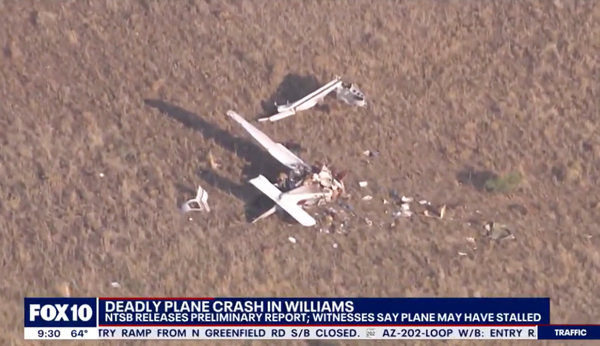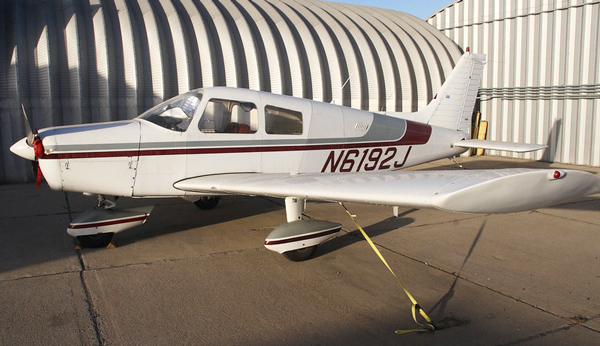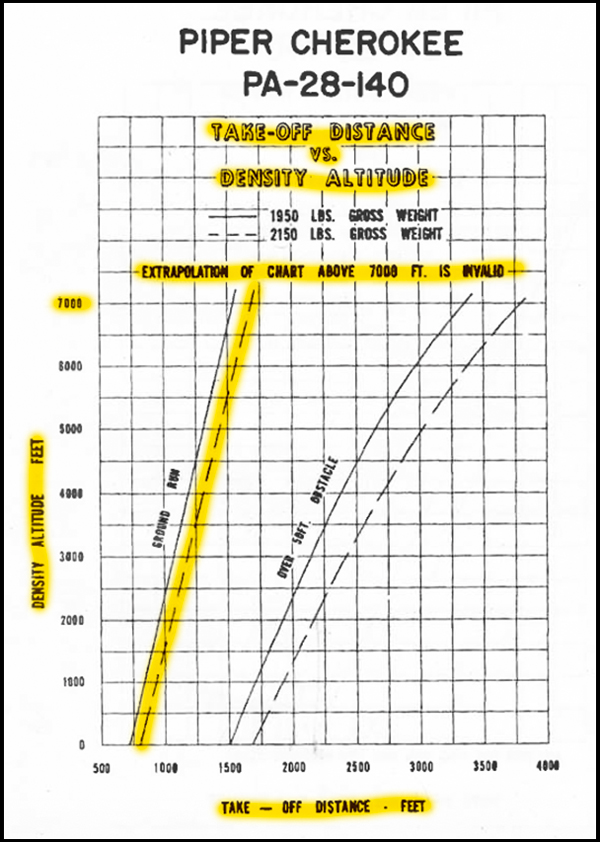SD-based Airplane Crashed in AZ Killing Three

By Arturo Castanares
Editor-at-Large
An October 17th crash of a San Diego-based airplane near Williams, Arizona, killed two flight instructors and a passenger in what seems to have been a case of pilot error by overloading the small airplane when departing from a high-altitude airport.

Accident coverage on Fox10 Phoenix (link)
The 1976 Piper Cherokee PA28-140, tail number N6192J, a single-engine four-seat airplane, crashed less than half a mile from H.A. Clark Memorial Field Airport in Williams, Arizona, about 30 miles west of Flagstaff at the south end of the Grand Canyon.
Witnesses describe seeing the airplane struggle to gain altitude after takeoff, and one witness said the airplane's wings rocked back and forth before losing control and crashing into the rocky terrain.
The Federal Aviation Administration (FAA) reports that the three occupants were pilot Kyemoon Kim, 31, a San Diego-based flight instructor from South Korea; Christopher Evans, 41, a flight instructor from La Mesa; and Dakota L. Almazan, 51, of Las Vegas, a former Las Vegas police officer.
Both Kim and Evans were certified flight instructors while they each worked toward earning their Airline Transport Pilot (ATP) ratings to become commercial airline pilots.
It is not clear if they were using the trip for flight training or simply building flight hours.
The FAA now requires that pilots have a minimum of 1,500 flight hours before becoming commercial airline pilots so students usually work as flight instructors for several years to gain the required hours.
The accident airplane had been rented from First Flight Corp., a flight school located on Brown Field Airport in Otay Mesa. In addition to being used for training students, airplanes are offered for rent to qualified pilots for travel or to build time toward their next certification. The airplane had an engine overhaul just a few months before the accident.

Accident airplane photographed at Brown Field in 2009. Photo credit: Keld Bonfizz
The airplane departed Brown Field at around 6:30 pm on October 15th and made stops in North Las Vegas; St. George, Utah; and Williams, Arizona, over the next two days.
The crash happened upon departing the Williams airport just after noon on October 17th. The airport is located at an elevation of 6,690 feet above sea level and the temperature reached a high of 77 degrees Fahrenheit on the day of the accident.
Two factors greatly affect the performance of an airplane; density altitude and weight.
Density altitude is the adjusted altitude calculated based on air temperature above or below the standard temperature of 59 degrees F (15 degrees C) and altitude above or below mean sea level (MSL) used to calculate expected airplane performance.
At standard temperature and sea level, the density altitude is equal to the stated altitude but, at higher temperatures, density altitude calculates the true air density based on the current temperature conditions.
The FAA estimates that, due to the higher air temperature at the time of departure, the density altitude at the 6,690' high airport was calculated to be the equivalent of 9,100' mean sea level.
Hotter and thinner air adversely affect the performance of airplanes with carbureted engines like in the accident airplane. Turbocharged and jet engines are not affected by changes in altitude because they compress the same amount of air into an engine irrespective of the current altitude.
The Pilot Operating Handbook (POH) for a Cherokee 140 includes a performance chart based on density altitude that estimates the expected performance of the airplane at different levels, as well as a chart showing the expected performance based on the airplane's total weight at takeoff.
All airplanes must carry a copy of the POH and pilots are taught to calculate density altitude performance when operating from high altitude airports and on hot days to ensure safe operation of the airplane.
At standard temperature and sea level, a typical Cherokee 140, like the accident aircraft, would expect to experience a climb rate of about 650' per minute, typical of small single-engine airplanes.

But, at a density altitude of over 9,000' like at the time of the accident, the airplane’s climb performance degrades to less than 300' per minute, a reduction in engine performance of more than 50% due to the thinner and hotter air, making it more difficult for the airplane to climb and maintain flight.
Additionally, a pilot must properly adjust the fuel mixture lever in the airplane to compensate for thinner air at high altitudes to ensure the best engine performance by reducing the amount of fuel introduced into the carburetor to maintain the power fuel-to-air ratio. Failure to properly set the engine's mixture lever during takeoff would result in lower engine output, further reducing the airplane's ability to climb.
The typical Piper Cherokee 140 has a maximum takeoff weight of 2,150 pounds, and, with its full fuel capacity of 50 gallons, the remaining payload weight for occupants and baggage is no more than 875 pounds to stay within the safe weight limits of the airplane.
The accident airplane took on 20 gallons of additional fuel at the Williams airport before its doomed departure.
Although the total weight of the airplane at the time of the accident is not yet known, the airplane full of fuel and three full-sized passengers with their luggage for a multi-day trip would be close to the maximum takeoff weight of the airplane.
Reduced airplane engine performance at high altitudes requires pilots to carefully calculate performance and runway distance needed for takeoff to ensure the airplane can fly safely under those conditions.
The airplane's handbook includes a chart calculating the takeoff and landing performance depending on density altitude, but is not useful above a density altitude of 7,000'.

The chart shows that the airplane would require more runway length to reach its minimum takeoff speed needed to generate sufficient lift to take flight, but the chart only calculates performance up to a density altitude of 7,000' above sea level, stating that "extrapolation of chart above 7,000 feet is invalid."
At sea level, the airplane would use about 800' of runway to reach its required takeoff speed, but the chart shows the distance needed at an elevation of 7,000' jumps to over 1,600' and could be about 2,000' at an elevation of 9,100' MSL, more than three times the runway length required given the reduced power output at high altitude.
The increased runway length needed for takeoff at high altitudes demonstrate the reduced power output of small airplane engines.
Pilots experiencing high density altitudes which could make flight difficult sometimes wait for cooler temperatures to lower the density altitude or reduce the takeoff weight of the airplane by removing luggage, reducing the amount of fuel, or flying with fewer passengers.
In a situation like what Kim faced, experts recommend that airplanes transport a passenger and luggage to a lower altitude airport then return for the second passenger before regrouping to all fly together from the safer airport.
The FAA and the National Transportation Safety Board (NTSB) will conduct a full investigation to determine the cause of the accident which usually take up to two years before a final report is released.
Castañares is the Publisher and Editor-at-Large of La Prensa San Diego. He has received several journalism awards, including the Ruben Salazar Award for Excellence in Print Journalism, the San Diego County Taxpayers' Association Media Watchdog award, and several First Place awards from the San Diego Pro Chapter of the Society of Professional Journalists. Castañares is also an FAA-certificated private pilot. He can be reached directly at art@laprensasd.com.






